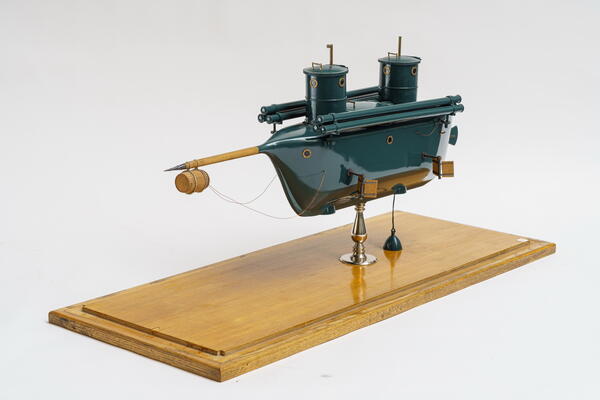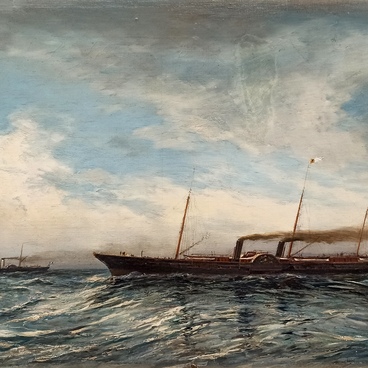One of the most interesting submarines of the early 19th century was the world’s first all-metal submarine built at the Alexandrovsky Foundry in Saint Petersburg in 1834. It was based on the design of the military engineer aide-de-camp general Karl Andreyevich Schilder. With its general design and details (such as the conning tower, periscope, crests, fan, and mine), Schilder’s submarine was very similar to the design of Kazymyr Chernovsky who developed his submarine when he was a political prisoner of Shlisselburg.
The submarine hull had a slightly flattened and elongated ovoid shape. The boat was lined with boiler plates attached to the frames using rivets. The submarine had a length of 6 m, a width of 1.52 m, and a height of 1.85 m. There were two cons with a height of about 1 meter for entering the submarine. Weights were suspended on rawhide ropes in two tapered cavities at the bottom of the submarine hull, and by lowering them to the sea bottom with a hoist, it was possible to reduce the weight of the submarine by 1,280 kg, after which it would lay motionless at anchor. Inside the submarine, there was a ballast tank that could be used to lower the submarine to a depth of up to 12.2 m. Water was pumped out of the tank by a manual piston pump. The submarine was propelled by four paddles (similar to duck feet) operated manually. The boat had a nominal speed of 2.15 km/h but during testing, its speed did not exceed 670 meters per hour. At the forward end of the submarine, a horizontal bowsprit (a spar) was fixed on the stem post. It had a length of 2 m and a diameter of 12 cm and had a spear attached at the end. A 16-kg powder mine was hung on the spear, with a wire leading from the mine to a galvanic battery inside the submarine. Apart from that, two three-pipe launching devices for incendiary and high-explosive Congreve rockets were installed along the sides. The submarine could fire in both single shots and salvos.
The submarine was tested in August 1834, with solid-propelled rockets being launched from underwater for the first time in history. The submarine crew consisted of 10 people, including an officer. The first commander — midshipman N.R. Zhmelyov — became the first submarine officer in the Russian Navy. Due to the limited speed characteristics of the submarine, Schilder also designed the first project of a depot ship that could transport it to the target area.
In 1841, experiments with Schilder’s submarine were discontinued due to the impossibility of its practical application against the enemy.
The submarine hull had a slightly flattened and elongated ovoid shape. The boat was lined with boiler plates attached to the frames using rivets. The submarine had a length of 6 m, a width of 1.52 m, and a height of 1.85 m. There were two cons with a height of about 1 meter for entering the submarine. Weights were suspended on rawhide ropes in two tapered cavities at the bottom of the submarine hull, and by lowering them to the sea bottom with a hoist, it was possible to reduce the weight of the submarine by 1,280 kg, after which it would lay motionless at anchor. Inside the submarine, there was a ballast tank that could be used to lower the submarine to a depth of up to 12.2 m. Water was pumped out of the tank by a manual piston pump. The submarine was propelled by four paddles (similar to duck feet) operated manually. The boat had a nominal speed of 2.15 km/h but during testing, its speed did not exceed 670 meters per hour. At the forward end of the submarine, a horizontal bowsprit (a spar) was fixed on the stem post. It had a length of 2 m and a diameter of 12 cm and had a spear attached at the end. A 16-kg powder mine was hung on the spear, with a wire leading from the mine to a galvanic battery inside the submarine. Apart from that, two three-pipe launching devices for incendiary and high-explosive Congreve rockets were installed along the sides. The submarine could fire in both single shots and salvos.
The submarine was tested in August 1834, with solid-propelled rockets being launched from underwater for the first time in history. The submarine crew consisted of 10 people, including an officer. The first commander — midshipman N.R. Zhmelyov — became the first submarine officer in the Russian Navy. Due to the limited speed characteristics of the submarine, Schilder also designed the first project of a depot ship that could transport it to the target area.
In 1841, experiments with Schilder’s submarine were discontinued due to the impossibility of its practical application against the enemy.





